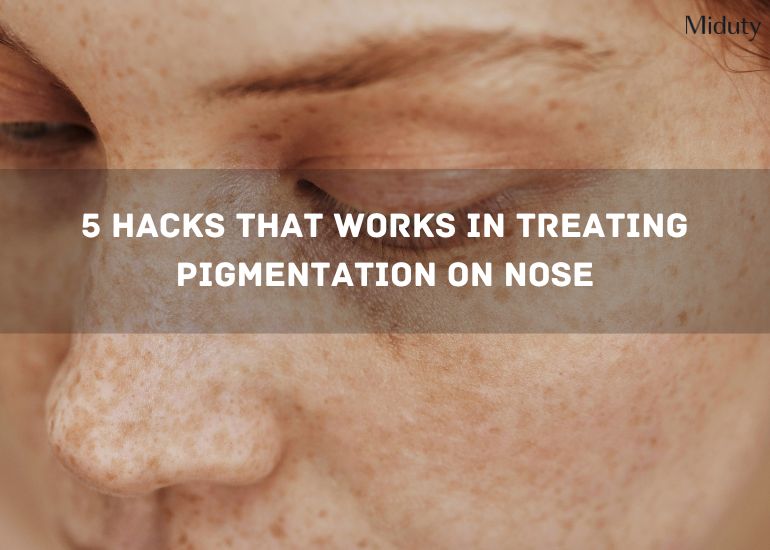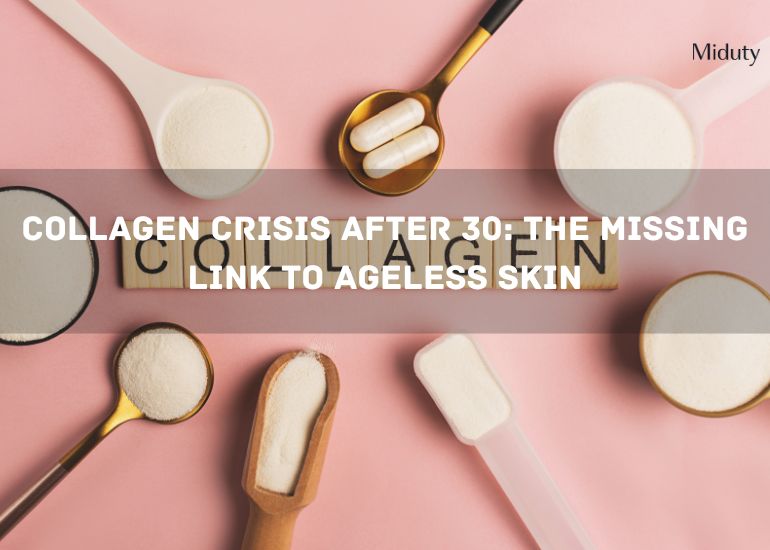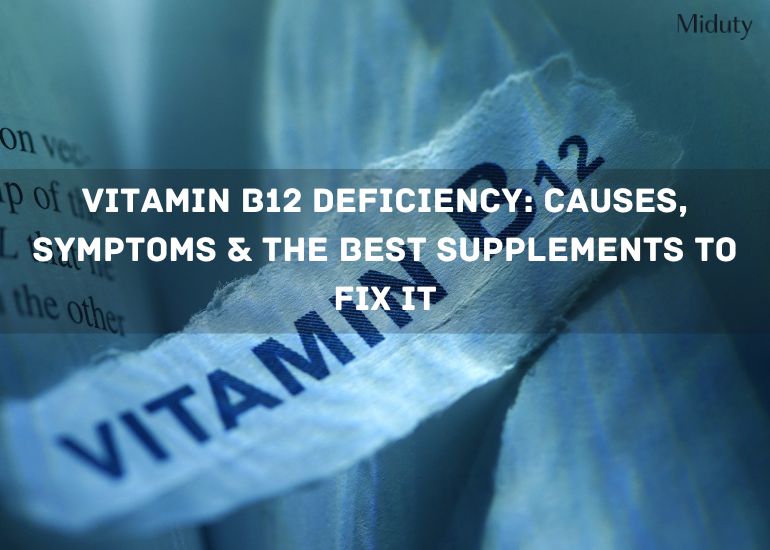
5 Hacks That Works In Treating Pigmentation on Nose
Key Takeaways
1. Common Causes: Pigmentation on the nose can be caused by several factors such as sun exposure, hormonal changes, post-inflammatory hyperpigmentation, aging, or genetics.
2. Topical Treatments: Ingredients like Vitamin C, retinoids, niacinamide, and alpha arbutin are popular for lightening pigmentation. Regularly applying these can give you visible improvements over time.
3. Professional Treatments: Chemical peels, such as glycolic acid and lactic acid peels help with pigmentation. And for stubborn pigmentation, you can opt for laser treatments as well under professional supervision.
4. Natural Remedies and Prevention: For mild pigmentation or prevention, aloe vera, turmeric, and green tea extracts are excellent natural remedies. But you will need to stay consistent.
5. Lifestyle Tips and What Not to Do for Pigmentation: Know some simple tips to keep your skin away from hyperpigmentation on or around your nose, or even your face along with practices to avoid when you're trying to reduce pigmentation. Such practices include harsh scrubs, lemon juice.

Have you noticed dark patches or spots on your nose lately? Wondering where they come from? You're definitely not alone!
Pigmentation on the nose can be a common issue people face and mostly remains a mystery to solve as it is difficult to know the reason behind it. Whether it's because of sun exposure, leftover scars from a breakout, or other factors, pigmentation can stand in the middle of your face and that's where nobody wants to have a skin issue.
People try out creams, over-the-counter solutions, DIY treatments, and more, just to find negligible to worsening effects. But some treatments can genuinely help hyperpigmentation on the nose, without draining your patience.
In this blog, we will help you understand what is pigmentation on the nose and how to remove pigmentation from the nose. Let's dive in!
Table of Contents
1. What is Pigmentation on Nose?
2. What Causes Pigmentation on Nose?
3. How to Remove Pigmentation from Nose?
5. When to See a Dermatologist?
6. Conclusion
7. FAQs on Pigmentation on Nose
8. References
What is Pigmentation on Nose?
Pigmentation on the nose is a common concern that can affect anyone, regardless of age or skin type. These dark or discolored patches often appear as hyperpigmentation on the nose or may also appear around the nose. With so many treatment options available, it's helpful to know what works and what may not be as effective.
Additionally, there can be several reasons for pigmentation around the nose, including sun exposure, hormonal shifts, or even lifestyle habits. So even before moving to the nose pigmentation treatments, knowing why you might be having hyperpigmentation on the nose is very important.
Also Read: Skin Pigmentation: Causes, Types, Treatments & Supplements
What Causes Pigmentation on Nose?
Pigmentation on the nose can stem from several factors. And, you can easily manage many of these causes with targeted nose pigmentation treatments or lifestyle changes.
1. Sun Exposure
The nose is a prominent area to receive direct sunlight which makes it more prone to sun-induced pigmentation. Ultraviolet (UV) rays stimulate melanin production causing hyperpigmentation around the nose. It may look like dark patches or spots on or around the nose.
2. Hormonal Changes
Hormonal fluctuations, often due to pregnancy, menopause, or birth control pills, can contribute to pigmentation on the nose. We call this condition melasma and it is common around facial areas, including the nose.
3. Post-Inflammatory Hyperpigmentation (PIH)
PIH occurs when skin darkens in response to inflammation, injury, or acne. This can be especially common if you've had acne on or around the nose.
4. Aging and Genetics
Age spots and sun spots become more common as skin matures, while genetics can also contribute to pigmentation on the nose.
5. Allergic Reactions
Skin conditions like eczema or allergic reactions can cause repeated irritation and inflammation, leading to pigmentation over time. Constant scratching or rubbing of the nose can worsen discoloration.
6. Medicine-Induced Pigmentation
Certain medications, such as antibiotics, hormonal treatments, or chemotherapy drugs, can increase skin sensitivity to the sun, making the nose more prone to pigmentation. Always check medication side effects and take extra sun protection measures if needed.
How to Remove Nose Pigmentation ?

When it comes to removing or reducing pigmentation on the nose, there are several effective ways ranging from skincare treatments to medical procedures. Here's a closer look at each:
I. Topical Treatments
Topical solutions are a go-to for treating pigmentation on the nose due to their convenience and effectiveness. Key ingredients to look at in topical nose pigmentation treatment include:
- Vitamin C: This antioxidant helps brighten skin and lighten hyperpigmentation around the nose. Regular use can improve skin tone over time and reduce the appearance of dark spots or patches. Make sure you incorporate Vitamin C-based skincare products in the night-time routine as it may get oxidized when used during the day. [1]
- Retinoids (Vitamin A derivatives): Retinoids speed up the skin cell turnover, helping fade pigmentation on the nose. Over-the-counter retinol or prescription retinoids like tretinoin are options to explore. Responsible usage is the key for such ingredients as over-usage may irritate the skin. Start by using lower concentration only once or twice a week. [2].
- Niacinamide (Vitamin B3): Niacinamide is a gentle alternative to harsh chemicals. Known for its ability to reduce dark spots gently, niacinamide is soothing and suitable for sensitive skin as well. Look for niacinamide-based products that have a concentration of at least 3-5%, this will help you get targeted treatment to reduce pigmentation and dark spots. [3].
- Alpha Arbutin: Derived from plants, alpha arbutin is a mild skin brightener, making it a good option for those with sensitive skin prone to pigmentation. Always rely on well-reputed brands to ensure there are no side effects caused and you get purity and trust. [4]
Miduty's Tip: Use sunscreen daily when using topical nose pigmentation treatment, as such treatments may make your skin more sensitive to sunlight.
II. Nutrition Supplements
While topical treatments work from the outside, there should be something that fixes the condition from within. For this reason, you can consider adding some supplements to your routine which may help treat hyperpigmentation anywhere on the skin, that too, internally. Supplements usually have long-term results with other health benefits as well.
Some supplements that may help target pigmentation on the nose are:
- NAC (N-Acetyl Cysteine) & Milk Thistle: One of the major causes of pigmentation is the harmful toxins present in the body due to environmental stressors like pollution, cosmetics, and other lifestyle factors. NAC and Milk Thistle, when taken in combination, help in the elimination of these toxins, giving you a toxin-free body, which ultimately results in naturally flawless and even-toned skin. NAC also helps in raising the Glutathione (a powerful antioxidant) levels in the body, helping in reduced oxidative stress and thus, pigmentation. [5]
Also Read: N-Acetylcysteine: Your Secret Weapon for Detoxification and Immunity
- Antioxidants: Antioxidants are crucial for managing the oxidative stress in the body. When this oxidative stress rises and there are free radicals, the synthesis of melanin pigment increases, leading to hyperpigmentation on the nose or the face.
Oral consumption of antioxidants like Resveratrol or Glutathione, thus, helps in neutralizing the free radicals and reducing oxidative stress. This makes the pigmentation on the nose go away and your skin glow like never before, because when your body thrives from within, your skin will become naturally flawless. [6][7]
III. Laser Treatments
Known to target melanin deposits in the skin, laser treatments help lighten hyperpigmentation on the nose. Here are some common laser treatments available for pigmentation around the nose:
- Fractional Laser: Fractional lasers function by creating tiny wounds for resurfacing the skin. This process includes the microscopic tissue injuries which help in skin remodelling. It encourages new skin growth, resulting in reduced pigmentation on the nose or the targeted area.
- Intense Pulsed Light (IPL): It is commonly used for sun-induced or UV-induced pigmentation. Unlike lasers, IPL uses broad-spectrum light for treating pigmentation. This treatment offers a non-surgical way to improve the color pigment or texture of the skin.
- Q-Switched Laser: This laser targets pigment-producing cells particularly, which is helpful for melasma conditions around the nose. It is non-invasive and works by using short pulses of light that particularly target pigments like melanin.
Remember, While lasers are effective, they can be costly and may require multiple sessions. They should also be performed by a certified dermatologist to avoid any risks. However, it is suggested to go with the simpler nose pigmentation treatments first if they work for you!
IV. Natural Remedies
If natural treatments are your go-to, then you should try these ingredients that can help reduce pigmentation on the nose. Keep in mind that natural remedies may take longer to show results and are best suited for mild pigmentation.
- Aloe Vera: Known for its healing properties, aloe vera contains aloin, a compound that may lighten dark spots. Thus, aloe vera helps with reducing pigmentation or dark spots. [8]
How to apply? Apply fresh aloe vera gel daily to the affected area for best results.
- Turmeric: This spice has been used in skincare for centuries. Curcumin in turmeric helps with reduced melanin production in the skin cells, which may cause dark spots and pigmentation around the nose. [9]
How to apply? You can mix turmeric with honey or curd to create a paste and use it regularly for desired results.
- Green Tea Extract: Green tea extract may help lighten pigmentation on the nose with its antioxidant properties because of the EGCG present in it. It prevents melanin accumulation in the skin. [10]
How to apply? You can use products containing green tea or apply cooled green tea bags directly to your nose for that antioxidant boost in your skin.
V. Lifestyle Tips for Preventing Pigmentation on Nose
Prevention is often the best way to tackle pigmentation, and simple lifestyle changes can go a long way. Here are some steps that can help you prevent pigmentation from worsening:
- Apply Sunscreen Daily: Use a broad-spectrum sunscreen with an SPF of 30 or more with broad-spectrum protection from both UVA and UVB radiations. Reapply every two hours, especially if you're outdoors.
Also Read: Sunscreen or Moisturizer First : What to Apply? - Learn the Right Skincare Order for Better Results
- Maintain a Healthy Diet: Antioxidant-rich foods, like berries, spinach, and green tea, can help protect skin from oxidative damage, which often leads to pigmentation around the nose or on the entire face.
- Stay Hydrated: Drinking plenty of water helps in flushing out toxins from the body, which in turn, helps skin maintain a natural, even tone and thus, less pigmentation. Target at least 3 liters of water every day.
- Quit Smoking: Smoking reduces blood flow to the skin, making it more prone to discoloration and pigmentation over time. So less smoking may help in reducing pigmentation on the nose, mouth, or anywhere on your body.
- Practice Gentle Skincare: Use a mild cleanser and avoid over-exfoliating the skin on your nose, as excessive scrubbing can strip off the natural oils and may also worsen pigmentation. Don't use harsh chemicals in your skincare routine and always perform a patch-test before adding any product to your routine.
|
Treatment |
Effective For |
May Not Work For |
|
Topical Treatments |
Hyperpigmentation, Melasma |
Deep, Stubborn Pigmentation |
|
Nutrition Supplements |
Deep Pigmentation, Melasma |
-NA- |
|
Laser Treatments |
Deep Pigmentation, Melasma |
Mild Pigmentation |
|
Natural Remedies |
Light Pigmentation |
Stubborn, Deep Pigmentation |
|
Lifestyle Changes |
Prevention of Further Dark Spots |
Existing, Deep-set Pigmentation |
Common Ineffective Methods for Treating Pigmentation on Nose
Knowing what doesn't work is as important as knowing what does. Some common methods are ineffective and may even worsen hyperpigmentation around the nose or on it.
1. Harsh Scrubs: Physical exfoliants, particularly harsh scrubs, can irritate pigmented skin and potentially worsen the condition. So being gentle on your skin is the key.
2. DIY Lemon Treatments: Lemon juice is often touted as a natural brightener, but its high acidity can irritate the skin, increasing sun sensitivity as well. So don't just follow trends; research well about anything that you're going to use on your skin.
3. Skipping Sunscreen: Without daily sun protection, any pigmentation treatment becomes far less effective, as UV rays can further darken spots. So skipping sunscreen is never an option.
When to see a Dermatologist?
If home nose pigmentation treatments are not working or you're noticing pigmentation getting worse, it's better to consult a dermatologist. They can assess your skin type and suggest appropriate treatments, like prescription-strength creams or medical procedures as per your skin requirement. Your skin might be giving you signs that you need help and such signs may include:
- Pigmentation darkening or spreading.
- OTC treatments do not improve pigmentation in a few months.
- You're noticing itching, swelling, or pain around pigmented areas.
Conclusion
Treating pigmentation on the nose is rarely a one-size-fits-all journey. As we now know the various factors that may have caused hyperpigmentation on the nose, we can easily figure out what's good for treating the condition.
While chemical peels, laser, or topical treatments can be effective ways, there are certain costs, commitment, and potential side effects. In some cases, medical treatments might be required to see significant results. Whereas, for some, only a simple routine having appropriate SPF, Vitamin C serum, gentle exfoliation, or adding suitable supplements to your routine may work.
Don't seek overnight results in nose pigmentation treatments, rather it is advised to be consistent with the methods you are opting for. Otherwise, consult a dermatologist to get your confidence back!

Frequently Asked Questions on Pigmentation on Nose
Q1 - How can I get rid of pigmentation on my nose?
You can start with detoxifying your body from the inside to get rid of pigmentation on the nose. For this, you may take NAC and milk thistle-based supplements. And, to speed up the process, you may consider topical treatments along with supplementation.
Q2 - Which vitamin deficiency causes pigmentation on the nose?
Skin lesions can be associated with a deficiency of vitamin B12. This deficiency may reflect hyperpigmentation, vitiligo, and hair changes as well. In many cases, we are unaware of the deficiency because of the malabsorption of this nutrient. So make sure you take the bioavailable form of Vitamin B12, which is methylcobalamin.
Q3 - Is Vitamin C good for hyperpigmentation?
Yes, Vitamin C is good for treating hyperpigmentation. Vitamin C is a great antioxidant and it may give you results in as early as 2-4 weeks. But make sure you don’t apply Vitamin C-based products in the daytime as they get oxidized very quickly when they come in contact with the sunlight. It could also irritate the skin.
Q4 - Why is my nose so dark?
There can be a number of reasons for a dark nose. Some of such causes include excessive sun exposure, dry skin, rosacea, and aging, or it can also appear as a side effect of certain medications.
References

References








